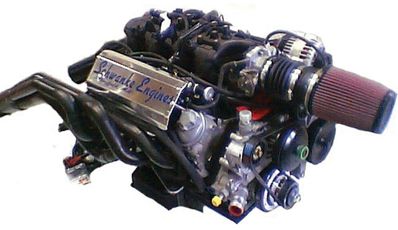
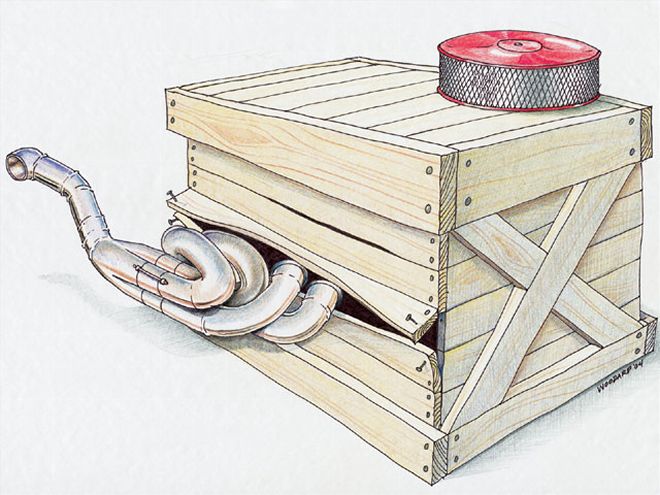
It has become a part of the racing environment, and it is really showing itself for the '04 season. It's the debate about the use of crate engines or sealed engines. Opinions are varied, usually depending upon your role in the sport. For the most part, engine builders don't like them. Promoters want to embrace them. Racers are hearing they will cut costs, so they are naturally in favor, if it's truly the case. No one knows for certain if this is a trend or a fad.
We sought opinions on matters like cost, durability, and the general effect of the crate engines on racing.
The supporters believe it will save the racers in the short and long run. But there is an opposing school of thought that it could cost more in the long run. Racers have been faced with numerous ideas that were touted as money savers, yet no one seems to be opening a money market account with the money not spent.
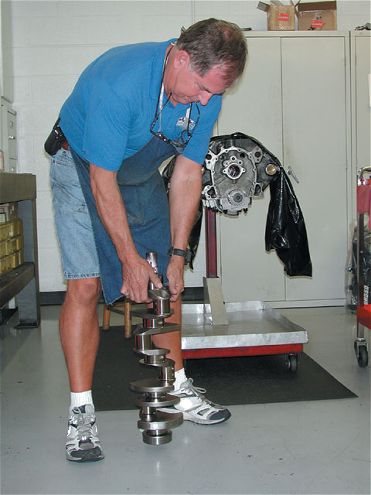 Keith Dorton, shown here checking a crankshaft, is a strong opponent to the concept of crate engines.
Keith Dorton, shown here checking a crankshaft, is a strong opponent to the concept of crate engines.
"They're being brainwashed to thinking it's substantially cheaper," says Keith Dorton of Automotive Specialists. "When you first look at it, $7,500 for this engine that has more horsepower is an attraction. It's possible to build an engine in this price range, but you have to consider the pieces inside it. The $19,000 Late Model Stock engines can run six seasons if you don't have any catastrophes like running out of oil or something. The rods in these crate motors, they're production rods. In one season, you're holding your breath at the end, I assure you. It's gone past its recommended life."
"Our crate motors are competitive with our $20,000 motors," says American Canadian Tour head Tom Curley, who started a crate engine program in his series nearly five years ago. "Basically, everyone now has given up on the [$20,000] engine because of the cost, and everybody will buy a couple of crate engines so they have a spare. Our guys go two years-two full years-before they have to do anything if they take care of their oil changes."
"Lower cost usually means lower-quality parts," says Bob Koch of Race Engineering Inc., a manufacturer of engine components. "This is like the stupid O.E. rod rules that don't save money. Many aftermarket rods are cheaper and much stronger. Broken rods cost plenty. How many racers have skipped this season because of a $2,000 or $3,000 freshen-up cost? Now they want them to buy a crate engine plus accessories to run. Over the past 20 years, Race Engineering has seen costs of many items come down dramatically, specifically American-made steel rods and crankshafts. Quality and durability have not suffered."
The cost of engines is just one aspect of the overall cost of racing. There are other areas where cost reductions can be seen with greater immediate benefit, according to Dorton.
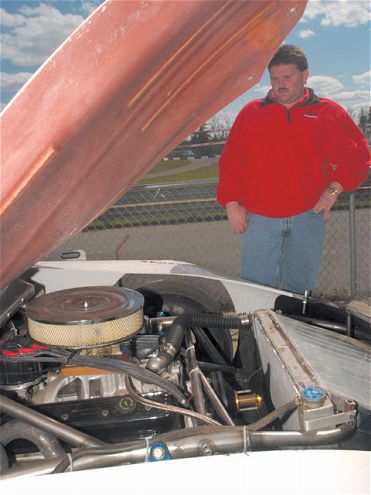 The crate engine program has been successful in the American Canadian Tour. Tour promoter Tom Curley has also mandated a crate engine for some weekly racers at his tracks.
The crate engine program has been successful in the American Canadian Tour. Tour promoter Tom Curley has also mandated a crate engine for some weekly racers at his tracks.
"Most of the costs going up have been absorbed by the engine builders over the past few years," says Dorton. "What we really need is a spec trailer. You've seen guys at the racetrack who are running in a two-barrel division, and they pull up with $300,000 rigs. Is that necessary for racing?"
"If costs really need to be contained, it's time for racers, manufacturers, promoters, and track techs to sit down and develop practical rules that can easily make sense," offers Koch. "Parts selection should make sense. The cheapest part is not always the most cost effective in a race engine. Rules that overly restrict engines also drive up costs."
Tim Schwanke of Schwanke Engines produces a sealed engine. While some may consider it a "crate" engine, Schwanke offers his view: "In my opinion, a sealed engine is a production engine modified for race use, and it uses electronic fuel injection. A crate engine is a mass produced engine that is carbureted. We have a sealed engine program. A lot of series have sealed engines, like the IRL, who leases their engines like we offer. A crate engine is distributed via a corporate network and sold as an engine. We sell ours as a program."
Proponents of the crate engines see parity winning out in the divisions using the engine. In the ACT, a few teams dominated the action. The introduction of the crate engine saw an increase in first-time winners and a greater number of winners in the course of the season. GM Product Specialist Gary Penn says crate engines offer a chance, especially in lower divisions. "If you're a backmarker, for example, and you now have the opportunity to run the same engine as the front runners, it's a great opportunity."
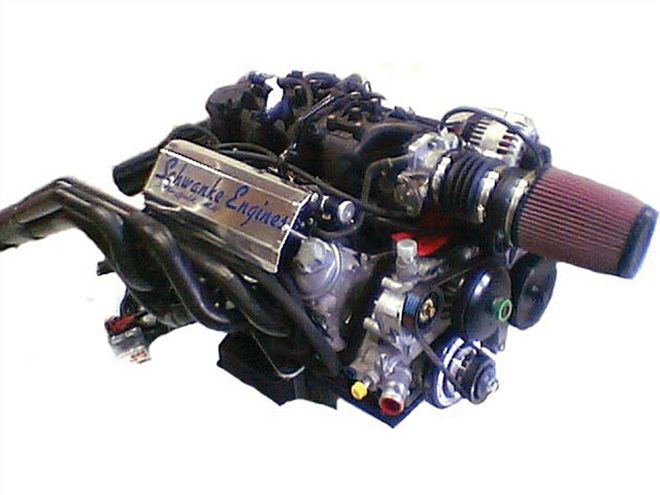 Schwanke Engines has developed programs with dirt and asphalt tracks across the country that cover a number of divisions. Its 425hp option is one of four considered by the tracks.
Schwanke Engines has developed programs with dirt and asphalt tracks across the country that cover a number of divisions. Its 425hp option is one of four considered by the tracks.
"As we see it, this rule would truly dull the competitive spirit of what racing really is," says Al Hovis, president of Hovis Racing Engines, "forcing all the racers to run the exact same cookie-cutter engines that they would be forbidden to modify in any way, virtually the hardest thing possible for a true racer to do."
"Let me tell you what is already happening and will continue to happen," says Dorton. "Say you have 20 cars that run a weekly series, and 15 of them have the crate motor and the others are racing on their other engines because it's all they have left. Do you think all 20 of them are the same? There's no way. They're racers. They've spent $7,500 on their crate motors. They're going to call whomever was doing their Late Model Stock and say, 'What can I do to this thing?' They're going to say, 'Everybody has the same power, and I need an advantage.' It's the way of the racer. We either manufacture or buy the bolts and seals and tear the engine down and put in a longer rod, lightweight pistons, change the cam profile, or whatever, and pick it up 30 horsepower. It will not stop at that. That $7,500 engine could easily cost $27,000 before the year is over."
"With chassis rules and setup knowledge so equal today, and all cars with the same power level, all that the fans would see is a parade of cool-looking race cars going in a circle," says Hovis.
"Isn't racing really more than just driving?" asks Koch. "It takes thought, study, and planning to choose the right cam, rod length, etc. These affect performance-not cost. What's the difference if the best driver or the guy with the biggest wallet always wins? Nothing. Shouldn't brains, planning, teamwork, and effort count for something?"
For racing purposes, GM has been at the forefront of the development of the racing crate engine. Ford and Chrysler have joined the fray, giving racers a choice in the matter, provided the track or series is doing the same. For the most part, series are mandating GM engines, usually the ZZ4, under the hood. Body style can often be any make.
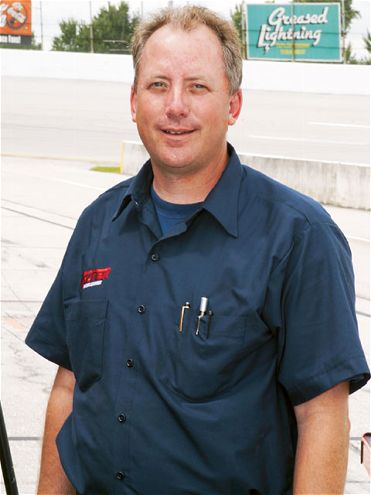
Dorton believes the crate engine idea spawned from a realization that engine builders who were specializing in racing engines were making the factory parts perform better. "For quite a few years, we made a good living preparing GM blocks for racing purposes," Dorton says. "We had one individual who developed a billet cap that tied everything together. We put hundreds and hundreds of those caps on hundreds and hundreds of blocks and prepped them for teams. GM eventually improved the quality of their castings and started selling a race-prepared block. They were tired of people making money off them. The company that I was buying the billet main caps from all of a sudden called me and said, 'I'm not going to be able to supply you with caps anymore.' He got the contract to build for GM."
In many of the crate programs, a track or series designates a particular engine builder as the source of the engines. In some cases, the engines are purchased directly from the track.
Schwanke believes racers need more than just an engine to make the idea work. He has developed a whole program that has been tried with racetracks.
"You manage the program by managing the computer," says Schwanke. "It's easier to tech and easier to manage. It involves rotating the computers and looking at the seals."
He cites an example of a track in Pennsylvania that uses the sealed engines and computer modules. At the end of hot laps, the track tech officials approach the cars with a cardboard box that contains the electronics boxes. The competitor takes the box from his car, drops it into the cardboard box, and pulls out a new box. It's a random selection, designed to discourage any alteration.
"Without the computer technology and the rotation of the components, you open up the possibility of something going wrong," Schwanke says. "In order to be successful, the program has to be managed."
Schwanke's engines are built to a horsepower level. His programs are developed with the idea of either outright purchase or an engine lease option.
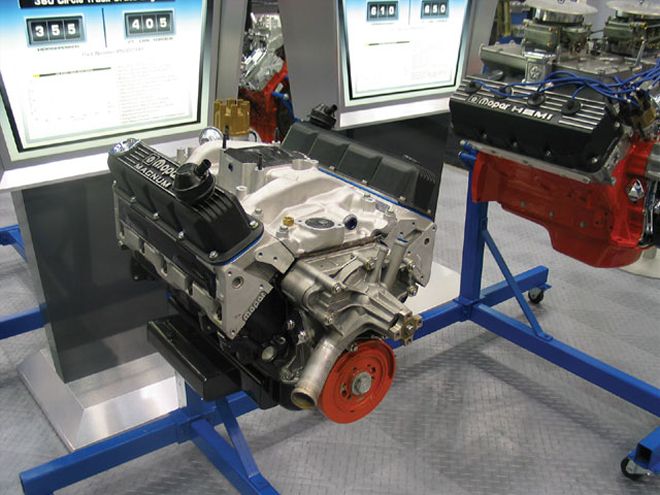 While General Motors led the way on the creation of racing crate engines, Chrysler...
While General Motors led the way on the creation of racing crate engines, Chrysler...
In addition to the actual cost factor, many see the crate engine as a threat to the future of the lifeblood of racing-the research and development that has led to the state of the sport.
Engine builders faced with the prospect of losing business have started to look at options. Some have explored building engines for dirt Late Models, which appear to be among the last to make a change, though Cherokee Speedway in South Carolina will be instituting a crate engine plan in 2004.
In addition, the racing aftermarket will be affected by the idea. "The parts suppliers who make pistons, cranks, rods, heads, cams, blocks, pans, etc., would be virtually run out of business," says Hovis. "That's not to mention all the fine machine shops and machine shop equipment manufacturers. All of the ongoing research and development that shows up each year in engine products would dry up. The aftermarket sponsorship help that a lot of racers count on would simply no longer be there."
"Your engine builder worked past midnight because you needed your motor for Saturday night and you're leading the points," continues Koch. "He was at the track in 35 degree weather to make sure you stayed in the show. Now he's out of work.
"What about innovation? Who is responsible for all the trick new parts? Detroit? Track owners? No, it's the manufacturers and companies that work with engine builders and race teams to produce what the market wants."
Schwanke's program enlists the help of aftermarket companies. "In our sealed engines, there are 27 aftermarket companies involved," Schwanke says. "We are not alienating the aftermarket because we need the aftermarket. It's more advantageous for us to use their advice with this new technology. Valvesprings, rod bolts, pans, belts, accessory drives, injection harnesses-they're all aftermarket. My direction was never to exclude the aftermarket."
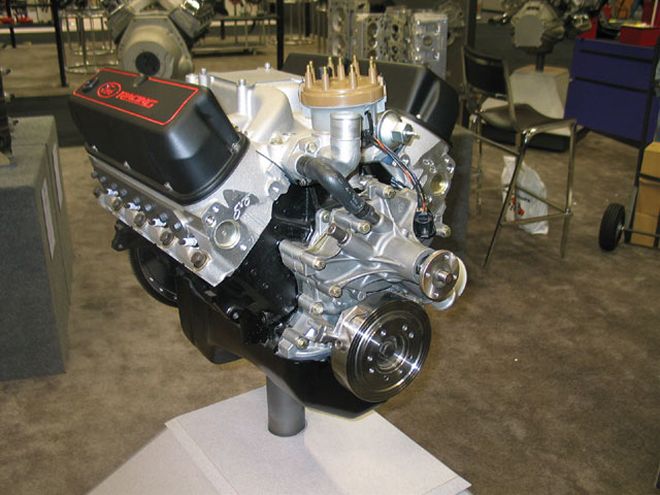 ...and Ford are attempting to close the gap. Each is making an alternative to the ZZ4, with an eye on similar horsepower and torque figures.
...and Ford are attempting to close the gap. Each is making an alternative to the ZZ4, with an eye on similar horsepower and torque figures.
If the opponents of the crate engine believe it will not work, they must have other ideas in mind. In many cases, they do.
"I don't have a specific recommendation," says Dorton, "but I have a theory that would work. You've got to do something to keep money from being the only way to win races. Ingenuity and driver ability and crew ability is what should win races, not cubic dollars. I'd like to be involved in specific ways to do it. I could be very helpful in that respect. Maybe it's fuel injection.
"I still haven't been able to grasp the feasibility of having to worry about restricting speed, yet allowing exotic cylinder heads and induction systems to come about. Why did we have to go from an 18 degree head to an SB2? It obsoleted everything out there. Why not leave the 18 degree heads alone and let you progress some of the technology from there?"
The direction concerns Hovis: "What's next, crate chassis? The racers' ingenuity would cease to exist. The mechanical chess game of power, longevity, and the delicate balance thereof would end. This truly is the heart and soul of racing. In our opinion, the crate rule would be the beginning of the end of racing as we love it. A realistic and enforceable engine claim rule would accomplish what the crate rule would not."
"Everybody in our sport, including the racer, needs to pay attention to the crate engine trend," says Koch. "Track owners need to understand where this type of program will lead. Those of us in the parts and assembly business will do well to work with racers and operators, to supply race quality parts at affordable prices, and come up with rules that make sense. Or we can stand back and watch another American industry bite the dust."
"Racing cannot exist at its current cost level," says Schwanke. "Promoters need a program to help keep the sport going. A sealed engine program is one step that will help the future of the sport."
The debate could go on infinitely. Existing examples of success like the ACT program support the idea of crate engines, but unanswered questions remain. This dialog will continue, maybe as long as racing itself exists.